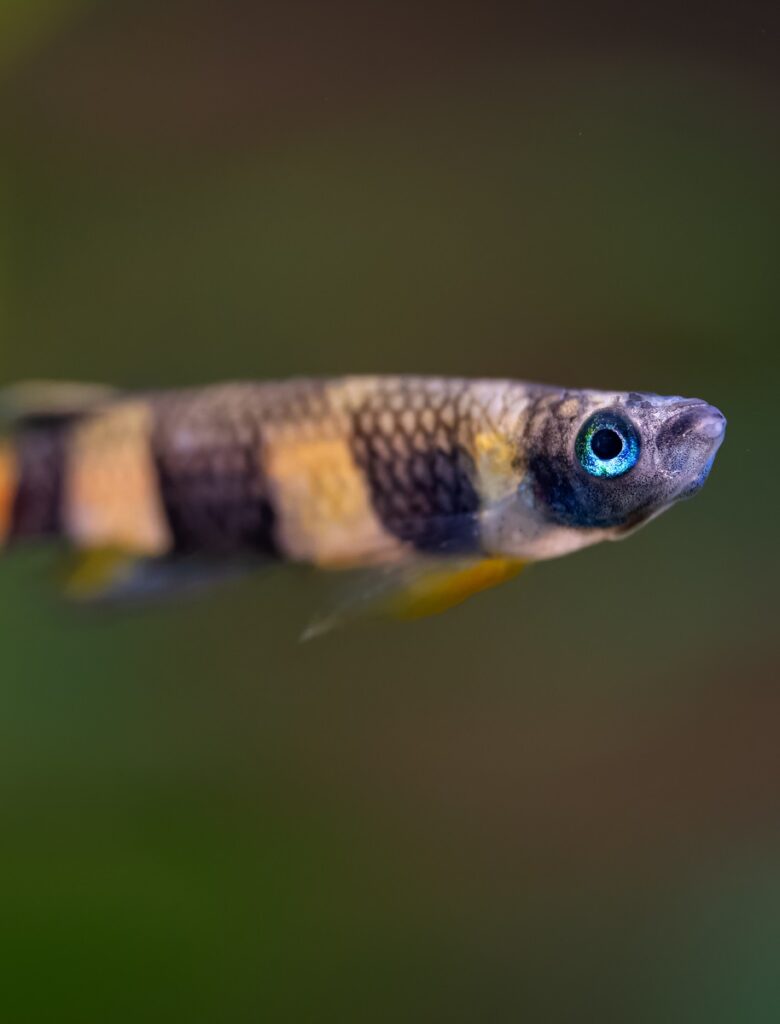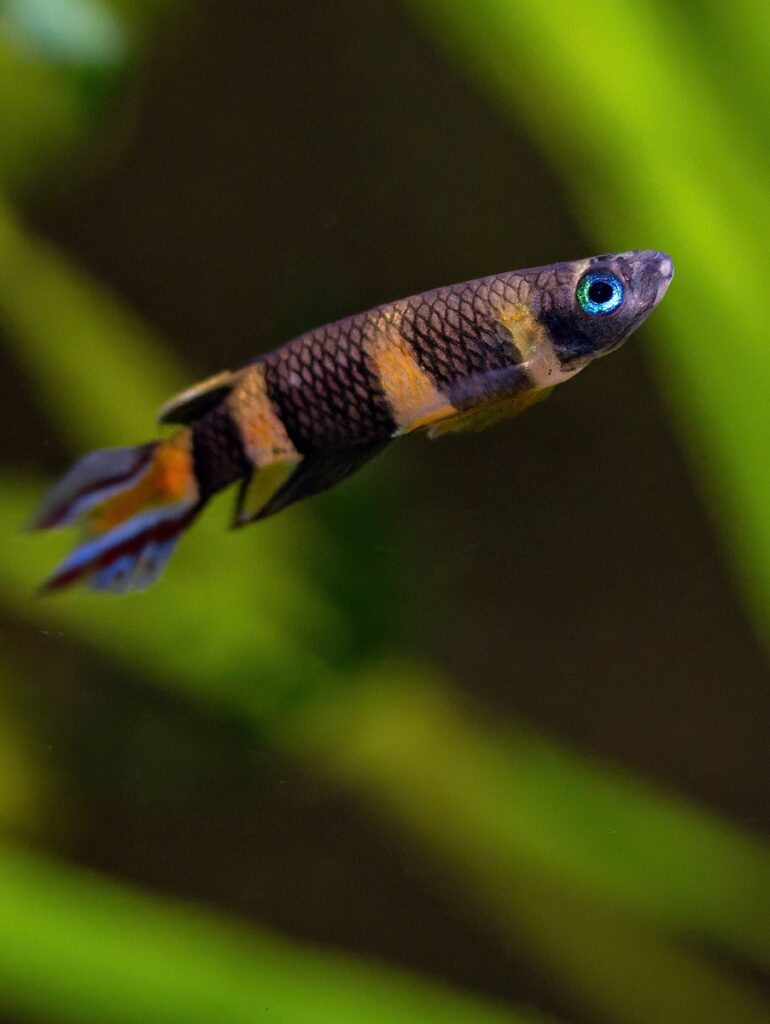Clown Killifish Care & Info | Epiplatys annulatus
Looking for a colorful surface dweller for your peaceful community aquarium? Or maybe an interesting breeding project? You'll love the striking clown killifish, one of the more popular killifish in the aquarium hobby. Some aquarists have noted that clown killies are difficult to keep alive, but as you'll see, you should absolutely be able to have success with them as long as you know what they need.
Below, find out everything you need to know about clown killifish and how to make sure yours thrive!
| Scientific name | Epiplatys annulatus* |
| Common names | Clown killifish, banded panchax, rocket killifish |
| Difficulty level | Intermediate |
| Origin | West Africa |
Table of Contents
Clown killifish appearance & natural habitat
Appearance
The clown killifish (or just clown killi) is a small fish belonging to the family Nothobranchiidae, an offshoot of a larger suborder of fishes called the Aplocheiloidei. In the aquarium hobby, all members of this order, including today's subject, are known as killifishes or panchax.
The clown killi is a typical killifish in terms of looks—which means it's quite the stunner. It's small, reaching only around 1.5" in length, and sports an elongated body. The head is small and rounded, with oversized shimmering blue eyes and an upturned mouth for catching small insects and other bugs. The caudal fin is placed very far back and almost touches the tail fin.
Both male and female clowns are appreciated for their bee-like pattern of alternating brownish and yellowish-to-tan vertical stripes (four of each color). However, it's the males that are the real stunners, with oversized fins and a bright red tail meant to help them woo the ladies.
Natural habitat
Killifish are named after "kills", an old word of Dutch origin that refers to a creek, stream, or similar small body of water. Most killies are specialized natives of these types of waters, and clowns are no exception.
The clown killifish is naturally found in West Africa, in the countries of Liberia, Sierra Leone, and Guinea. In these tropical regions, clown killies inhabit soft, acidic lowland swamps and streams. These waters are often shallow and slow-flowing or stagnant, with plenty of leaf litter, overhanging vegetation, and aquatic plants.
Because clown killies are generally found relatively close to the coast, the water in the streams they favor can be lightly brackish. The exact water composition varies according to the time of year, as these regions do have a pronounced rainy season.
Did you know? The IUCN Red List considers Epiplatys annulatus to be a species of Least Concern in the wild.
Setting up a clown killifish aquarium
Requirements
Although clown killifish can do alright in regular community aquariums, ideally you'd try to imitate the conditions in their natural habitat. This especially helps if you're interested in breeding. So how do you do this? Well, you basically have to take a "more is more" approach!
An aquarium of at least 10 gallons in volume is considered the minimum for this species. The ideal set-up for clown killifish would be heavily planted, including floating plants to dim the light and provide extra cover. Going for low-light plant species like Anubias works best. You can also include plenty of leaf litter, driftwood and roots, and other decor you like. Avoid rocks that increase the water hardness, like seiryu stone.
It's important to remember that these killies naturally inhabit waters with very low or even non-existent flow levels. In our tanks, we generally like to crank up the flow to ensure proper filtration and oxygenation, but you'll really have to keep it gentle for the clowns. A lot of aquarists opt for sponge filters or even create unfiltered set-ups (recommended for experienced fishkeepers only).
What you will 100% need is a tank lid. These are notorious jumpers!
Did you know? The streams these fish inhabit in the wild are often very shallow, sometimes even just an inch or two deep. In the aquarium, clown killies are top dwellers, almost exclusively staying in the upper water layer. This means a (very) shallow aquarium tends to work better for them than a deep one.
Water parameters
Aquarists sometimes have trouble keeping their clown killifish healthy. It's been speculated this is due to the fact that they don't deal well with change, which is why we recommend finding out in what parameters they were kept by the seller and try to match those if possible. A mature aquarium that's at least a few months old should work best; it should always be fully cycled.
After bringing your clown killies home, be sure to acclimate them slowly. Stay on top of regular water tests and water changes.
pH: 5-7
Temperature: 73-78 °F
TDS: 50-150
Tankmates
Clown killifish are timid and not very assertive, so they don't do well with more boisterous species. Instead, it's best to keep them in a peaceful community aquarium or set up a single-species tank for them. The latter is almost a must if you're looking to breed your killies.
Because these killies don't tend to bother their tankmates, generally keeping to themselves in the top water layer, you've got a few options. Just go for docile species that like similar water parameters, such as:
You can also keep clown killifish with shrimp, though keep in mind that they will eat baby dwarf shrimp. If you don't want this to happen, you could go for larger Amano shrimp, although some sources do report that these have a taste for killifish eggs. Snails, such as Nerites, would also be a good option.
Although this is not a schooling or even a shoaling fish—most of the time, individuals hang out all over their tanks instead of banding together—you should definitely keep multiple clown killifish. Just try to get at least two females for every male, as the boys can squabble.
Clown killifish diet
As we've mentioned, clown killifish are designed to eat fallen insects, worms, and other small invertebrates. In the aquarium, you can feed yours small floating pellets or flakes for carnivorous fish, but the most important thing is to provide plenty of (thawed) frozen foods and even live foods.
If you're attempting to breed your clown killies, live foods such as Daphnia or baby brine shrimp are pretty much a must! You could even try wingless fruit flies, as these fish are used to taking food from the surface.
Breeding clown killifish
Like many other killifish species, clown killies do breed readily in the aquarium. If you're looking for a fun breeding project, they might be just the thing! We have to note that there are a bunch of different methods for raising the fry and that opinions on which is the best differ, but you can always try multiple and see what works for you.
If you keep your killies in a heavily planted tank, you may see babies appearing by themselves over time. After all, these fish spawn pretty much daily, laying a few eggs at a time.
For the best survival rates, try the following:
- Set up a separate rearing tank with water from the main aquarium, preferably with a few plants and some leaf litter.
- If your fish aren't spawning yet, start feeding live foods and try a small water change with distilled water.
- Method 1: Add some Java moss or spawning mops to the tank. The adults like these for spawning purposes and will adhere their sticky eggs to them. Once there are enough eggs, move the spawning medium to the rearing tank. They will hatch in up to 12 days.
- Method 2: Leave the moss or mops in the main tank until you see baby killifish swimming around. Catch the tiny (so tiny!) fry and move them to the rearing tank.
- The plants and leaf litter should provide some infusoria for the fry to feed on, but it's likely you'll need to supplement with green water, rotifers, vinegar eels, and eventually baby brine shrimp.
- If any of the fry are significantly larger than the others (i.e. already a few weeks old while others are newly hatched), move the bigger ones to the main tank to prevent them from eating their siblings.
Buying clown killifish
Thanks to their relatively long lifespans (for a killifish) and striking patterns, clown killies are among the most popular killifish available in the general aquarium hobby. Most larger aquarium stores will carry them, or alternatively, they may be able to order a few in for you.
You can also buy these fish online. The Shrimp Farm carries clown killifish in packs of 3 with live arrival guarantee!
Frequently asked questions
Many killifishes are annual: they only live for a single year, as the streams they live in cease to exist in the dry season. Luckily for us, the same doesn't go for clown killies, which live for around 2-3 years.
Sources & further reading
Collier, G. E., Murphy, W. J., & Espinoza, M. (2009). Phylogeography of the genus Epiplatys (Aplocheiloidea: Cyprinodontiformes). Molecular Phylogenetics and Evolution, 50(1), 190-196.



 Shrimp
Shrimp Fish
Fish Crab &
Crab & Plants
Plants Foods
Foods Snails
Snails

